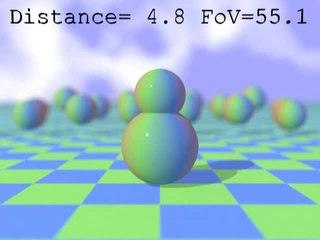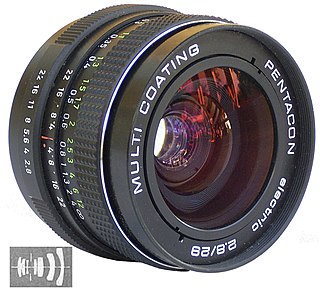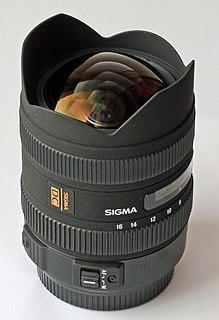
A rangefinder camera is a camera fitted with a rangefinder, typically a split-image rangefinder: a range-finding focusing mechanism allowing the photographer to measure the subject distance and take photographs that are in sharp focus. Most varieties of rangefinder show two images of the same subject, one of which moves when a calibrated wheel is turned; when the two images coincide and fuse into one, the distance can be read off the wheel. Older, non-coupled rangefinder cameras display the focusing distance and require the photographer to transfer the value to the lens focus ring; cameras without built-in rangefinders could have an external rangefinder fitted into the accessory shoe. Earlier cameras of this type had separate viewfinder and rangefinder windows; later the rangefinder was incorporated into the viewfinder. More modern designs have rangefinders coupled to the focusing mechanism so that the lens is focused correctly when the rangefinder images fuse; compare with the focusing screen in non-autofocus SLRs.

The angle of view is the decisive variable for the visual perception of the size or projection of the size of an object.

A dolly zoom is an in-camera effect that appears to undermine normal visual perception.

A camera lens is an optical lens or assembly of lenses used in conjunction with a camera body and mechanism to make images of objects either on photographic film or on other media capable of storing an image chemically or electronically.

In photography and cinematography, a wide-angle lens refers to a lens whose focal length is substantially smaller than the focal length of a normal lens for a given film plane. This type of lens allows more of the scene to be included in the photograph, which is useful in architectural, interior and landscape photography where the photographer may not be able to move farther from the scene to photograph it.

A zoom lens is a mechanical assembly of lens elements for which the focal length can be varied, as opposed to a fixed focal length (FFL) lens.

The Four Thirds System is a standard created by Olympus and Eastman Kodak for digital single-lens reflex camera (DSLR) and mirrorless camera design and development.

In photography and cinematography, perspective distortion is a warping or transformation of an object and its surrounding area that differs significantly from what the object would look like with a normal focal length, due to the relative scale of nearby and distant features. Perspective distortion is determined by the relative distances at which the image is captured and viewed, and is due to the angle of view of the image being either wider or narrower than the angle of view at which the image is viewed, hence the apparent relative distances differing from what is expected. Related to this concept is axial magnification -- the perceived depth of objects at a given magnification.

Digital zoom is a method of decreasing the precise angle of view of a digital photograph or video image. It is accomplished by cropping an image down to an area with the same aspect ratio as the original, and scaling the image up to the dimensions of the original. The camera's optics are not adjusted. It is accomplished electronically, so no optical resolution is gained. Digital zooming may be enhanced by computationally expensive algorithms which sometimes involves artificial intelligence.

The EF lens mount is the standard lens mount on the Canon EOS family of SLR film and digital cameras. EF stands for "Electro-Focus": automatic focusing on EF lenses is handled by a dedicated electric motor built into the lens. Mechanically, it is a bayonet-style mount, and all communication between camera and lens takes place through electrical contacts; there are no mechanical levers or plungers. The mount was first introduced in 1987.

In film and photography, a prime lens is a fixed focal length photographic lens, typically with a maximum aperture from f2.8 to f1.2. The term can also mean the primary lens in a combination lens system. Confusion between these two meanings can occur if context doesn't make the interpretation clear. People sometimes use alternate terms—primary focal length, fixed focal length, or FFL to avoid ambiguity.

Macro photography is extreme close-up photography, usually of very small subjects and living organisms like insects, in which the size of the subject in the photograph is greater than life size . By the original definition, a macro photograph is one in which the size of the subject on the negative or image sensor is life size or greater. In some senses, however, it refers to a finished photograph of a subject that is greater than life size.

In digital photography, the crop factor, format factor, or focal length multiplier of an image sensor format is the ratio of the dimensions of a camera's imaging area compared to a reference format; most often, this term is applied to digital cameras, relative to 35 mm film format as a reference. In the case of digital cameras, the imaging device would be a digital sensor. The most commonly used definition of crop factor is the ratio of a 35 mm frame's diagonal (43.3 mm) to the diagonal of the image sensor in question; that is, CF=diag35mm / diagsensor. Given the same 3:2 aspect ratio as 35mm's 36 mm × 24 mm area, this is equivalent to the ratio of heights or ratio of widths; the ratio of sensor areas is the square of the crop factor.
A parfocal lens is a lens that stays in focus when magnification/focal length is changed. There is inevitably some amount of focus error, but too small to be considered significant.

Image stabilization (IS) is a family of techniques that reduce blurring associated with the motion of a camera or other imaging device during exposure.

In photography, a close-up lens is a simple secondary lens used to enable macro photography without requiring a specialised primary lens. They work like reading glasses, allowing a primary lens to focus more closely. Bringing the focus closer allows the photographer more possibilities.
The design of photographic lenses for use in still or cine cameras is intended to produce a lens that yields the most acceptable rendition of the subject being photographed within a range of constraints that include cost, weight and materials. For many other optical devices such as telescopes, microscopes and theodolites where the visual image is observed but often not recorded the design can often be significantly simpler than is the case in a camera where every image is captured on film or image sensor and can be subject to detailed scrutiny at a later stage. Photographic lenses also include those used in enlargers and projectors.

The Panasonic Lumix DMC-GH1 is a digital mirrorless interchangeable lens camera adhering to the Olympus and Panasonic developed Micro Four Thirds System (MFT) system design standard. Panasonic classified the GH1 as a hybrid stills/video camera and the GH1 was introduced and marketed as a higher end camera than Panasonic's first MFT camera, the stills only, non-video capable Lumix DMC-G1.
In photography, a long-focus lens is a camera lens which has a focal length that is longer than the diagonal measure of the film or sensor that receives its image. It is used to make distant objects appear magnified with magnification increasing as longer focal length lenses are used. A long-focus lens is one of three basic photographic lens types classified by relative focal length, the other two being a normal lens and a wide-angle lens. As with other types of camera lenses, the focal length is usually expressed in a millimeter value written on the lens, for example: a 500 mm lens. The most common type of long-focus lens is the telephoto lens, which incorporate a special lens group known as a telephoto group to make the physical length of the lens shorter than the focal length.

The Sigma 8–16mm lens is an enthusiast-level, ultra wide-angle rectilinear zoom lens made by Sigma Corporation specifically for use with APS-C small format digital SLRs. It is the first ultrawide rectilinear zoom lens with a minimum focal length of 8 mm, designed specifically for APS-C size image sensors. The lens was introduced at the February 2010 Photo Marketing Association International Convention and Trade Show. At its release it was the widest viewing angle focal length available commercially for APS-C cameras. It is part of Sigma's DC line of lenses, meaning it was designed to have an image circle tailored to work with APS-C format cameras. The lens has a constant length regardless of optical zoom and focus with inner lens tube elements responding to these parameters. The lens has hypersonic zoom autofocus.

















